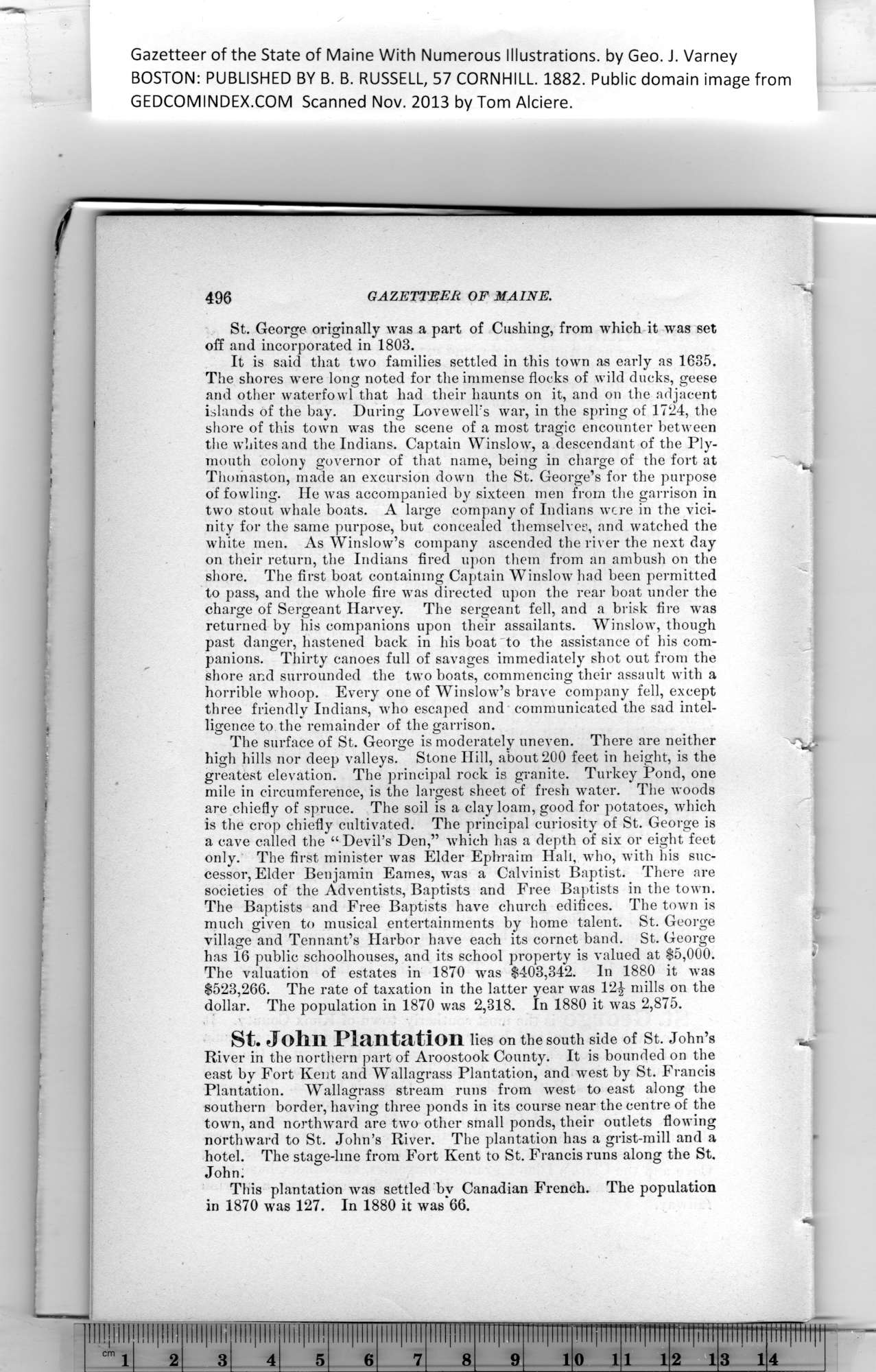|
Gazetteer of the State of Maine With Numerous Illustrations, by Geo. J. Varney
BOSTON: PUBLISHED BY B. B. RUSSELL, 57 CORNHILL. 1882. Public domain image from
496 GAZETTEER OF MAINE.
St. George originally was a part of Cushing, from which it was set
off and incorporated in 1803.
It is said that two families settled in this town as early as 1635.
The shores were long noted for the immense flocks of wild ducks, geese
and other waterfowl that had their haunts on it, and on the adjacent
islands of the bay. During Lovewell’s war, in the spring of 1724, the
shore of this town was the scene of a most tragic encounter between
the whites and the Indians. Captain Winslow, a descendant of the Ply-
mouth colony governor of that name, being in charge of the fort at
Thomaston, made an excursion down the St. George’s for the purpose
of fowling. He was accompanied by sixteen men from the garrison in
two stout whale boats. A large company of Indians were in the vici-
nity for the same purpose, but concealed themselves, and watched the
white men. As Winslow’s company ascended the river the next day
on their return, the Indians fired upon them from an ambush on the
shore. The first boat containing Captain Winslow had been permitted
to pass, and the whole fire was directed upon the rear boat under the
charge of Sergeant Harvey. The sergeant fell, and a brisk fire was
returned by his companions upon their assailants. Winslow, though
past danger, hastened back in his boat to the assistance of his com-
panions. Thirty canoes full of savages immediately' shot out from the
shore and surrounded the two boats, commencing their assault with a
horrible whoop. Every one of Winslow’s brave company fell, except
three friendly Indians, who escaped and communicated the sad intel-
ligence to the remainder of the garrison.
The surface of St. George is moderately uneven. There are neither
high hills nor deep valleys. Stone Hill, about 200 feet in height, is the
greatest elevation. The principal rock is granite. Turkey Pond, one
mile in circumference, is the largest sheet of fresh water. The woods
are chiefly of spruce. The soil is a clay loam, good for potatoes, which
is the crop chiefly cultivated. The principal curiosity of St. George is
a cave called the “ Devil’s Den,” which has a depth of six or eight feet
only. The first minister was Elder Ephraim Hall, who, with his suc-
cessor, Elder Benjamin Eames, was a Calvinist Baptist. There are
societies of the Adventists, Baptists and Free Baptists in the town.
The Baptists and Free Baptists have church edifices. The town is
much given to musical entertainments by home talent. St. George
village and Tennant’s Harbor have each its cornet band. St. George
has 16 public schoolhouses, and its school property is valued at $5,000.
The valuation of estates in 1870 was $403,342. In 1880 it was
$523,266. The rate of taxation in the latter year was 12^ mills on the
dollar. The population in 1870 was 2,318. In 1880 it was 2,875.
St. John Plantation lies on the south side of St. John’s
River in the northern part of Aroostook County. It is bounded on the
east by Fort Kent and Wallagrass Plantation, and west by St. Francis
Plantation. Wallagrass stream runs from west to east along the
southern border, having three ponds in its course near the centre of the
town, and northward are two other small ponds, their outlets flowing
northward to St. John’s River. The plantation has a grist-mill and a
hotel. The stage-line from Fort Kent to St. Francis runs along the St.
John.
This plantation was settled bv Canadian French. The population
in 1870 was 127. In 1880 it was 66.
PREVIOUS PAGE ... NEXT PAGE
This page was written in HTML using a program written in Python 3.2
|
